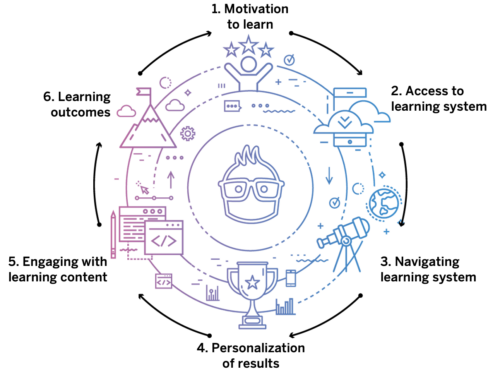What Are the Six Essentials of Empowered Learner Experience?
Learner experience is certainly not a new topic but it’s become increasingly important as the state of corporate training has changed. Learners have come to expect training to “do something” for them. It can’t just be another task to check off the list. It needs to add tangible value.
For example, workers across industries cite ongoing training as a “benefit” more important even than salary, which is why companies now use training programs and opportunities as a recruitment and retention strategy. Providing educational opportunities also breeds loyalty, with two-thirds of people saying they would be more likely to stay with a company that invested in continuous learning.
Providing ongoing training is the first step, but that’s not enough. That training also needs to deliver a great experience. That’s where things get a little more challenging – note that we’re saying challenging but also very doable.
How Do You Create Empowering Learner Experiences?
Based on findings from the SAP Learning Research Program, there are six essential elements to deliver learner experiences that engage people to learn at their best and want to come back repeatedly to do so again and again.
Essential 1: Always offer a motivation to learn
Employees have three different motivations to learn: they have to learn; they need to learn; or they want to learn.
- “Have to” learning happens when employees have to learn to fulfill a requirement, like compliance training.
- “Need to” learning happens when employees need to learn to be able to do their jobs, like onboarding or finding a solution to a problem that is stopping them from completing a task.
- “Want to” learning happens when employees want to learn to develop toward a new role or fulfill their curiosity.
Essential 2: Provide access to a learning system
We are aware of the fact that some companies are still struggling to provide a centralized learning hub, but the stark reality is that a learning system is required. Whether you opt for an LMS, LXP, or some similar system of choice, learning technology is necessary for success.
Once in place, that learning system needs to be easy to access on any device and equally available to all audiences (i.e. employees, customers, partners). Additionally, it should be accessible by different learner
types regardless of language, region, level of tech savvy-ness, disabilities, etc.
Essential 3: Ensure easy navigation of the learning system
As articulated in Essential #2, the system needs to be easy to access, but once accessed, it also needs to be easy to use. The reality is that business users now expect a more consumer-style experience. They don’t want their enterprise applications to feel like they’re from a prior decade than their beloved personal apps. This means it needs to have a modern design and layout, provide highly intuitive navigation, and offer the ability to personalize views to name just a few criteria.
Essential 4: Be sure to personalize results
Think what you will of the philosophy, but we live in a “what’s in for me culture” these days. People want to know how training benefits them specifically. Sure, there will always be mandatory compliance training or other required courses that people may not feel directly benefit them personally, but in general, it’s a best practice to explain to learners how the results of the training will help them. If the outcomes don’t feel personalized, interest and engagement will be lower.
When personalizing learning goals, also take into account a learner’s existing skill level and where they would like to be in terms of proficiency. When an employee knows how learning will improve their experience at work (e.g. skills achievement, role or career advancement, reskilling toward different role, etc.), they are more driven to learn.
Essential 5: Engage learners with quality content
Even with the most powerful learning technology in place, if it lacks good content, learners will not remain engaged. Learners have a variety of needs related to content, but all have a few in common:
- It needs to be engaging and incorporate interaction to maintain attention and interest.
- It needs to be factual and up-to-date. Learners might find the perfect content to answer their burning questions, only to find that it was developed years ago and is no longer relevant.
- It needs to be delivered in the way that the learner learns best. Offering content through different modalities – audio, text, video, etc. – and different “sizes” (lengths of time), ensures that learners can learn when and how they want.
Essential 6: Focus on providing positive outcomes
Learning outcomes look different for every learner experience. They may be as straightforward as remaining compliant and feeling a sense of accomplishment in doing so. They may be more sophisticated, such as finishing a task they were stuck on, fulfilling curiosity about a new topic, or making progress toward developing a new skill, etc.
Whether or not learners reach their outcomes is crucial. It’s what informs whether or not they will start the cycle over again. And getting them to restart the cycle is what creates continuous learning – a goal that every L&D department strives for!





